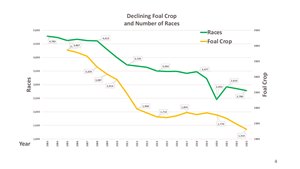Dollars & Sense: Finding a Path Forward in California


Last month Thoroughbred Owners of California president and CEO Bill Nader presented to the California Horse Racing Board a concerning table documenting the relationship between the decline in the state's foal crop and the decline in Thoroughbred races in the state.
It's not clear if either indicator, declining foal crops in the state or number of races, might be influencing the other, but it's certainly interesting to see that when placed on a line graph that the two indicators nearly mirror one another. The 2023 California foal crop of 1,314 is down 66% from 2005, while the 2,780 races offered in 2023 is down 42% since 2004.
Economist Lauren Stiroh saw the same relationship between the number of races and Thoroughbred breeding activity. She noted this while speaking at The Jockey Club's 2022 Round Table on Matters Pertaining to Racing.
"I looked at the number of races, the number of races coming down over time. It's highly correlated with the decline in the foal crop," Stiroh said. "There is clearly more of a rich story there."
Of course California's challenges have been well documented, and while there are a number of reasons worth examining, it's also fair to say that most of its problems boil down to the state not receiving money for its purses and tracks from added gaming. That's been the path forward for racing throughout the country, but it has eluded California.
With Golden Gate Fields scheduled to shut down this year, the state is considering all of its options.
"It's not a pretty picture whether you look north or you look south. This is our reality," Nader said at the Jan. 18 CHRB meeting. "The north is filled with uncertainty and the south is extremely vulnerable. The only real opportunity for an increase in purses and commissions is through ancillary revenue from a secondary source. This has proven more difficult than any of us would have hoped."
As the addition of such money is not on the horizon, other ideas are needed. One of those ideas would be consolidation, with horses from Golden Gate being added in the south. In his presentation to the CHRB, Nader offered some new ideas that the TOC hopes will reinvigorate racing in Southern California and breeding in the state if this plan moves forward. He noted that if a viable plan for Northern California racing emerges, the TOC would support that, but without such a plan unveiled, the TOC and Southern California tracks have developed a plan.
He said available stabling capacity at Del Mar, Santa Anita Park, Los Alamitos Race Course, and San Luis Rey training center can be used to accommodate the arrival of horses that have been based at Golden Gate.
The addition of a lower claiming race level in Southern California would provide suitable opportunities for the Golden Gate runners. He called for relocation allowances to facilitate the move of horses from Golden Gate to Southern California.
The TOC requested a legislative change that would permit Los Alamitos to card "night" Thoroughbred races at distances not restricted to 4 1/2 furlongs for $5,000 claimers and below. Nader added that such races would not be conducted on the same dates of any scheduled fair dates.
The TOC plan also calls for a close relationship with the fair circuit to support and secure their traditional footprint on the racing calendar.
